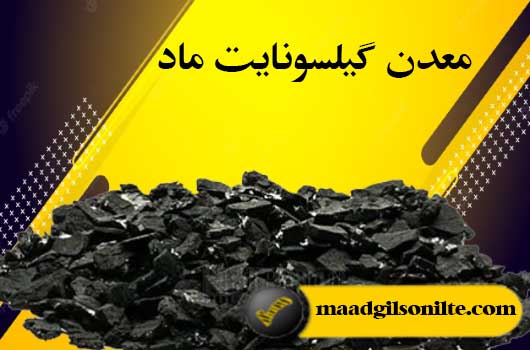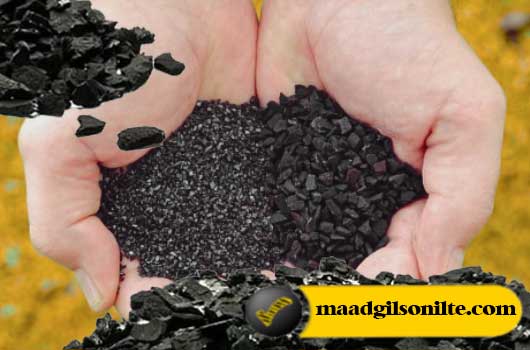
Production of activated carbon from gilsonite: gilsonite is one of the natural materials found in many parts of the world. Due to its antibacterial properties and high absorption, this material is very useful for use in industries such as pharmaceuticals, cosmetics, food and mineral industries. But one of the important applications of gilsonite is the production of activated carbon, which acts as a strong adsorbent for gases, chemicals and heavy metals.
To produce activated carbon from gilsonite, a series of steps are involved. The first step is to crush the gilsonite and grind it into a fine powder. This increases its surface area and increases its ability to absorb impurities. Once the powder is ready, it is heated to a high temperature in the absence of oxygen, a process known as carbonization. The heat breaks down the complex hydrocarbons in Gilsonite and converts them into elemental carbon.
Activated carbon can be produced in several ways. In the following two important methods are mentioned:
In this method, Gilsonite is combined with one of the active ingredients such as phosphoric, nitric or hydrochloric acid. Then it is mixed with gas or water vapor for several hours at high temperature and high pressure to oxidize and heat the mixture. Finally, a mixture of activated carbon and waste material is produced, which is obtained using methods such as filtration and drying.
In this method, Gilsonite is directly sealed at high temperature and high pressure with liquid gas or water vapor to oxidize and heat the mixture. In this method, activated carbon is obtained without using active substances. This method is used in many factories for the production of activated carbon due to its greater efficiency.
Activated carbon is used as a strong adsorbent for gases, chemicals and heavy metals. It is also used in water purification, removal of allergens and chemicals from the air, industrial gases, control of bad odors and dyes, pharmaceutical and cosmetic industries, food and mineral industries. Also, activated carbon is used to purify drinking water, remove chlorine and organic substances, colored substances, bad odors and suspended particles.
water refinery:
Water purification is one of the most important applications of activated carbon. The porous structure of gilsonite-derived activated carbon allows it to absorb organic compounds, chemicals, and even heavy metals in water. It can help remove unpleasant odors, improve taste, and make water safe for consumption. Activated carbon filters are commonly used in household water filters and large water treatment plants.
air conditioner:
In addition to water purification, Gilsonite-based activated carbon is also used in air filters. It can effectively remove volatile organic compounds (VOCs), gases and odors from the air. This is especially useful in industrial environments, where harmful gases are generated during production processes. By installing active carbon filters, these gases can be captured and the air purified before being released into the environment.
medical:
In addition, the medical field greatly benefits from the use of gilsonite-derived activated carbon. For example, activated carbon is used in emergency rooms to treat patients who have ingested poisons or overdosed on medications. The porous structure of activated carbon absorbs these harmful substances and prevents them from being absorbed by the body. It is also used to create gas masks that protect against toxic fumes in hazardous environments.

Production of activated carbon from gilsonite has several advantages. First, Gilsonite is a natural material, which makes it a renewable source of activated carbon. This can help reduce the environmental impact associated with other sources such as coal or coconut shells. In addition, Gilsonite-derived activated carbon exhibits excellent adsorption properties, making it very effective in various applications.
Activated carbon, produced from Gilsonite, is one of the important products in various industries. With its high density and spherical volume, this material is used in the production of industrial products such as pharmaceuticals, military, water and sewage, oil and gas, and petrochemicals.
Production of activated carbon has already been done in the country using plant materials. Due to the high capacity of agricultural waste, different provinces produce this material from different plant parts such as walnut and pistachio shells, rice husks, wood, etc.
But currently, the semi-industrial production line of activated carbon from natural bitumen with a production capacity of 100 tons per year is on the verge of receiving a production license and environmental approval. All the equipment of this production line has been built and supplied with the help of the private sector inside the country. This production line will also be introduced as one of the achievements of academic jihad last year in the anniversary ceremony of the establishment of this complex.
Production of activated carbon from gilsonite is one of the most important and effective methods for producing activated carbon. In these methods, using chemical and chemical processes, activated carbon with diverse properties and applications is obtained. The use of carbon in many industries seeks to improve quality and efficiency and protect the environment.

